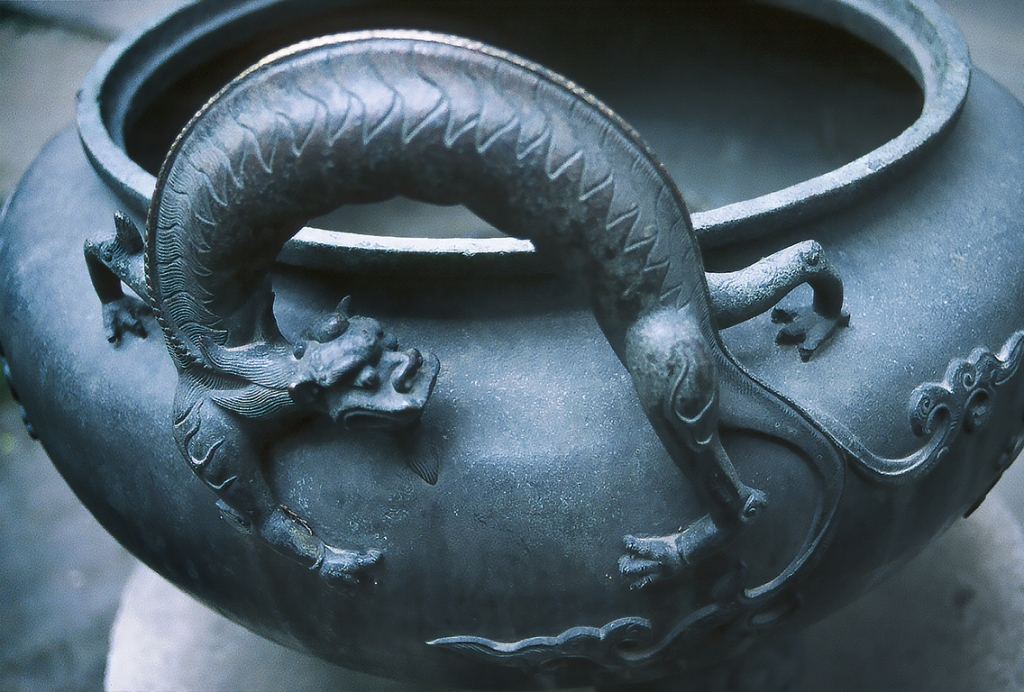I nodded an assent, then shook my head… paused. “What does that mean?”
She told me. I must still not have understood, because I’ve forgotten. Only the phrase is left. I couldn’t focus, and the image in my mind drifted away.
Like this photo of a dragon-handled brazier at Kong Miao, the Confucius Temple in Beijing. Ever so slightly, focussed too deep. And like a photograph, there is no way, hard as I’ve tried, to bring China fully into focus.
Yet I know China better than anyone I know. After six and a half months bicycling six thousand kilometers across it, you might think I grew to know it fairly well. But even the face of it is not very sharp.
Beautiful. Beguiling. Fascinating. Enthralling. Spectacular, even.
But not… quite… sharp.
Proximity and personal space baffles, annoys and delights me. Closerthanthis, Chinese people gathered around whenever my bicycle and I came to rest. Until I couldn’t see the trailer attached to my rear axle. Until I was treated to an intimate whiff of the weave of the fabrics comprising their clothing.
How can people always be so close to one another? Ten Chinese people with nothing to do will gather around a person actually doing something to watch them do it. Intently. Quietly. No offers of assistance. The person actually doing something, completely unperturbed by all the attention, will ignore the observers. Entirely.
I don’t get that. It was sometimes quite annoying, always being the centre of attention that way, but with just the barest of language skills I was often able to have a lot of fun, even laughter all around. They were obviously quite curious about me, and my bicycle — and their culture allows them to express that curiosity quite bluntly, so as long as I could feed that curiosity…
Well, it took a few months to get there. It wasn’t always fun.
“A riddle wrapped in a mystery inside an enigma,” Churchill once famously said of Russia. Imagine that you’ve unwrapped the riddle of China, cracked open the mystery and illuminated the enigma. You’d be looking at something more than a little alien, still.
It’s so appropriate that the dragon’s face is out of focus. “Face” is among the most important social concepts to grasp in Chinese life, and I know I constantly trampled and slapped faces all over the country. I’ve heard Westerners explain it among themselves. “Face, you know, like losing face.” But that’s not entirely it. It’s subtler and far more significant than that.
I learned, when seeking directions, never to point in one direction and ask, “Is this the right way to Beijing?” I nearly always received a smile and a firm nod in response, only to discover I was heading in entirely the wrong direction ten kilometers later. To disappoint someone is to lose face. Obviously, I wanted Beijing to be the in the direction I was pointing. No sense disappointing me.
I learned, instead, to ask, “Is Beijing this way? Or that way?” Having not stated a preference, my helpers were free to point me in the right direction.
Even if they didn’t know one.
I’m sure I’m getting this all wrong. That is the significance of the enigma.
Perhaps I was still causing some people to lose face with such queries? If they didn’t know which direction lead to Beijing, then telling me they didn’t know would disappoint me. After all, I’d politely asked them for a direction. Best to just offer one, and hope for the best.
But that’s the barest whisper of the complexities of face. It’s like that second tail trailing off in the distance. The little bit that’s in focus. There’s a whole lot of dragon that still not sharp at all.
And yet, I love this image. I love the arch of the dragon’s back, the splay of its tail, the monochrome tones even though it’s a full colour image. The frame itself is beautifully full, vibrant, in motion — there are so many places for the eye to look.
I just wish the dragon’s face was in focus!
Kong Miao (The Confucius Temple)
Beijing, China
Taken during travels, 1998
